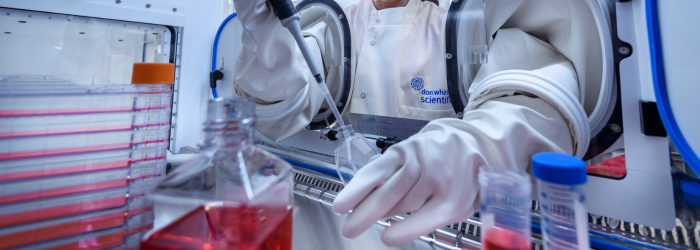
Can cancer researchers benefit from mimicking the body in their labs?
The tumour microenvironment, characterized by low oxygen levels (hypoxia), has been shown to impact cellular processes, including machinery functionality, viability, and gene/protein expression. Understanding the influence of hypoxia, often termed 'tumour physioxia,' is crucial in the research, discovery, and development of oncology treatments. Hypoxia's association with drug resistance and therapeutic inefficacy underscores its importance as a pivotal factor to address in oncological studies and treatment strategies.
Solid tumours, notorious for their adaptability, thrive within hypoxic microenvironments, fostering cellular resilience and treatment resistance. This necessitates a deeper understanding of cellular responses to oxygen deprivation for the advancement of oncological interventions. We uncover the profound implications of replicating in vivo physioxic conditions within the laboratory setting.
Study 1: Hypoxia's Influence on Tumour Biology
van de Schootbrugge et al. examined the impact of hypoxia on αB-crystallin expression in head and neck squamous cell carcinoma (HNSCC), uncovering its role in promoting cell survival under physioxia. αB-crystallin was more abundantly present in hypoxic areas of HNSCC biopsies than in normoxic areas whilst decreased αB-crystallin levels reduced cell survival under hypoxic conditions. Their findings shed light on the importance of mimicking the tumour microenvironment to reveal key survival mechanisms of cancer cells.
Study 2: Hypoxia and Treatment Resistance
Alam et al. investigated the contribution of HIF2α to antiestrogen resistance in breast cancer cells. Determining if there was any connection between hypoxia and therapeutic outcomes. Their findings highlighted hypoxia diminishes the effectiveness of antiestrogen treatments (tamoxifen and fulvestrant) in ERα-positive breast cancer cells, coinciding with elevated HIF2α expression and increased resistance to therapy Studying cells under physiologically relevant oxygen conditions to unravel treatment resistance mechanisms is a vital consideration for research design, drug development and accurate pharmacodynamic studies.
Study 3: Modulating Tumour Aggressiveness
Campbell et al. explored the impact of ascorbate availability on tumour behaviour under hypoxic conditions, revealing its role in modulating HIF1 activity and tumour aggression. Their study demonstrated a negative correlation between ascorbate availability and HIF1 response in LL/2 cells, indicating a potential role of ascorbate in modulating tumour aggression. The findings of this study present an argument for past, present and future therapies to be assessed under hypoxic conditions to improve the understanding and potential efficacy of cancer therapies for improved patient outcomes.
Study 4: Considerations for Accurate Research Under Hypoxia
Carreau et al. presented the critical role of oxygen partial pressure (pO2) in human tissues and its significance in maintaining physiological balance. Focusing closely on the impact of hypoxia on various organs and tissues. Particularly in pathological conditions such as cancer. The investigators emphasised 5 key considerations for performing accurate research under hypoxia:
- Physioxia Importance: Studying cells under physiologically relevant oxygen levels is crucial for accurately reflecting cellular behaviours and responses in various tissues and organs.
- Tumour Biology: Understanding the role of hypoxia in tumour microenvironments is essential for evaluating therapy efficacy and developing targeted treatment strategies.
- Experimental Relevance: By mimicking the oxygen levels found in specific organs, researchers can better understand the impact of oxygen on gene expression, proteome regulation, and overall cell activity.
- Experimental Accuracy: Understanding the impact of oxygen levels on cellular activities is essential for interpreting experimental results accurately and translating findings from in vitro studies to real-life clinical settings.
- Clinical Translation: Utilizing physiologically relevant oxygen conditions in experimental settings can enhance the translation of in vitro findings to real-life clinical scenarios, improving the relevance and applicability of research outcomes.
As researchers navigate the complexities of cancer, it becomes increasingly clear that mimicking the tumour microenvironment in the lab is not only advantageous but essential. By embracing physioxic conditions, new insights into tumour biology, treatment resistance mechanisms, and therapeutic strategies will be discovered.
References
- Alam, M., Persson, C., Reinbothe, S., Kazi, J., Rönnstrand, L., Wigerup, C., . . . Jögi, A. (2016). HIF2α contributes to antiestrogen resistance via positive bilateral crosstalk with EGFR in breast cancer cells. Oncotarget, 7(10), 11238-11250. doi:10.18632/oncotarget.7167
- Campbell, E., Vissers, M., & Dachs, G. (n.d.). Ascorbate availability affects tumor implantation-take rate and increases tumor rejection in Gulo-/- mice. Hypoxia (Auckl)., 8(4), 41-52. doi:10.2147/HP.S103088
- Carreau, A., El Hafny-Rahbi, B., Matejuk, A., Grillon, C., & Kieda, C. (2011). Why is the partial oxygen pressure of human tissues a crucial parameter? Small molecules and hypoxia. Journal of Cellular and Molecular Medicine, 15(6), 1239-1253. doi:10.1111/j.1582-4934.2011.01258.x
- van de Schootbrugge, C., Schults, E., Bussink, J., Span, P., Grénman, R., Pruijn, G., . . . Boelens, W. (2014). Effect of hypoxia on the expression of αB-crystallin in head and neck squamous cell carcinoma. BMC Cancer, 14(252). doi:10.1186/1471-2407-14-252


 en
en



 English
English